Observing the Earth
Today no one doubts that the Earth is round, especially when viewing the photos sent by satellites. However, we must bear in mind that we do not need these technological advances to affirm this, it is enough to analyze the phenomena of our environment to find those answers. Let's look for a moment at our Earth...
Image of the Earth

In the area of the sea, you will often have seen some boat moving away from the horizon. If you look carefully, the first section that is extinct is its helmet, in which only the mast is visible until its complete disappearance (see figure 1).
The study of the shadow of objects is another way of discarding the hypothesis of the flatness of the Earth. If we measure the shadows of the two sticks on the same day and at the same time in different places far from each other, the lengths should be equal if the Earth is flat. But it is not so. This observation clearly explains that shadows are of different dimensions. As can be seen in Figure 2, this phenomenon can be explained by the circular nature of the Earth.
In addition to what we can observe on Earth, by looking to heaven we can easily find the explanation of this statement.
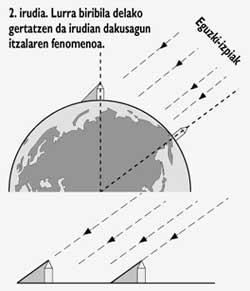
The old sailors went far to fish or meet other countries. In these trips the stars offered them great help, because thanks to them they could follow the right direction. Upon their return they discovered the rich lands and the most recent stars. How is it possible? Admitting that the earth is flat, it would be impossible to make different observations, since the appearance of the mass should be the same regardless of where we are. For example, as we head north we see the stars of the South increasingly below and those of the North ever higher.
Astronomical phenomena have always aroused human curiosity. Among them, eclipses are one of the most attractive. The fact that the Moon and the surface of the Sun appeared covered by a dark spot was formerly considered a punishment of God. Over time these beliefs have been overcome and today we know that these phenomena are due to the shadows of the Earth or the Moon.
When the Earth is between the Sun and the Moon, it casts its shadow on the surface of the Moon.
Have you ever looked at the shape of that shadow? Throughout the Moon eclipse we see the expansion of a circular disk along the surface of the Moon. As this shadow generates the Earth, we perceive its aspect.
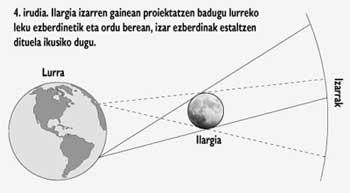
On Earth Movements
Rotation movement
Another phenomenon with our sense is the movement of stars and planets around us. We see them every day going east and entering west. How can we deduce the movement of Earth itself?
Suppose the Earth does not turn on its axis, then we could calculate the motion of the stars around the Earth knowing its distance.
Any kneading object, including the Sun and Moon, takes a full (360º) turn to Earth in 24 hours. Therefore, in an hour I would make a movement of fifteen degrees. As for the Moon, the distance to Earth is 384,000 km and using a well-known formula in geometry, we can calculate the speed of the Moon (see figure 3):
S = x R
S = 384,000 x 15 x> / 180 = 100.531 km
The
moon speed will be 100.531 km/h. We see that the moon moves between the stars. This means that the stars are behind the Moon. If we project the Moon on these stars from different points of the earth at the same time, we will see that it covers different stars (see figure 4). So the stars are much more backward than the Moon. If we assume that a star is 100 times farther, its speed will be 100 times higher than that of the Moon. And if the stars are much further away, it is impossible to give those speeds. The nearest star is 9.5 billion km away, its speed should be higher than that of light and, as we know, it is impossible. There is the statement.
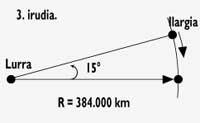
To explain that the Earth rotates on its axis other phenomena can be considered. If we throw an object from a tower, it is not just a vertical movement and we will see that it deviates to the southeast: the higher the speed the greater the detour. This phenomenon is a consequence of two different types of accelerations. Due to centrifugal acceleration it will deviate south in the northern hemisphere and north in the southern hemisphere. For its part, the acceleration of Coriolis will cause a deviation in both hemispheres to the East.
Due to the Earth's rotation motion, the object will move under these two accelerations, one centrifuge and another Coriolis acceleration (see Figure 5). So far we have mentioned an object that moves vertically, but the one that moves horizontally also suffers a similar deviation. As we have all seen, emptying a bathtub full of water produces a whirlpool. Why? The reason is the acceleration of Coriolis mentioned above. This acceleration deflects to the right in the northern hemisphere the object that moves horizontally and to the left in the southern hemisphere.
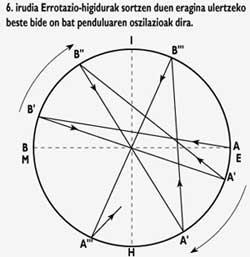
This phenomenon determines the general movement of winds and clouds. When a low pressure zone is created, the wind is directed towards the center, but the acceleration of Coriolis causes the molecules that form the wind to deviate to the right, creating a movement contrary to the clockwise. Another good way to understand the influence of the rotation movement is the oscillations of the pendulum.
If the Earth did not turn and we released the pendulum initially in the equal-west direction (point A) (see figure 6), it would be constantly oscillating between points A and B. The pendulum always oscillates on the same plane while it does not suffer any disturbance. But if we let it oscillate between points A and B, it will deviate to the right in the northern hemisphere, that is, the rotation movement of the Earth will turn the plane of oscillation of the pendulum in the direction of the clock hands and the other in the southern hemisphere. This indicates that there is a force that diverts the pendulum from its swing plane. This force is due to the acceleration of Coriolis.
Foucault in 1851 was the first to explain this phenomenon in Paris with a pendulum of 67 meters. This essay is a good test of the Earth's rotation movement.

Translation movement
Anyone will certainly tell us that the Earth revolves around the Sun. But how do we know? What kind of test do we need to confirm it? What phenomena make us think that is so? In the time of Copernicus they believed that the sky was perfect, that is, that the planets and all the stars formed circular movements and revolved around the Earth.
In that conviction, however, there were many phenomena to be clarified. For example, when observing the planet Mars they saw that its light was sometimes stronger and sometimes weaker, which would be impossible if it moved at the same distance from Earth and in circular orbit.
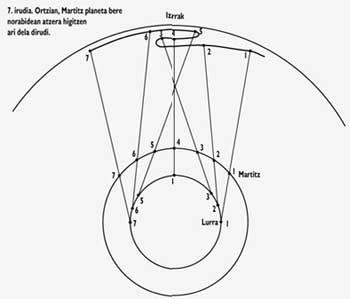
On Mars the retrograde movement was also incomprehensible to them. According to this, in the firmament it seems that the planet Martitz moves in its direction (see figure 7). We can postulate curious theories to solve these phenomena (as scientists of the time did at first), but the best and simplest explanation of these phenomena is to keep in mind that the Earth orbits around the Sun.
As mentioned above, the Moon covers different spaces in the firmament. If we observe a star closer to us from two different points, far from the orbit of the Earth around the Sun, when projecting the nearest star on stars further behind, we will observe that it appears in different places, as in the case of the Moon.
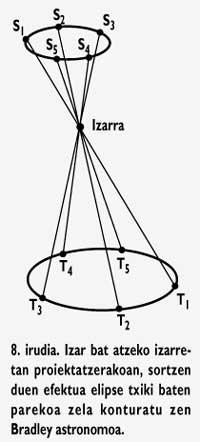
Ticho Brahe tried to understand and observe this phenomenon. With the understanding of the phenomenon he came to demonstrate the movement of Earth's translation. On the contrary, Ticho Brahe was not able to measure these angles because his instruments had a degree of accuracy too low. Therefore, he did not consider useful the theory that the Earth is spinning around the Sun.
The instruments that can be used today are much more precise and these angles can be measured. The precision needed to measure this phenomenon is necessary to see the diameter of the coin from 25 pesetas to 8 kilometers.
When projecting the aforementioned star into the rear stars, astronomer Bradley realized that the effect it produced was equivalent to a small ellipse (see figure 8). Bradley also realized that in the points theoretically calculated by him in this little ellipse the star did not appear. There was therefore an unstudied phenomenon: Aberration phenomenon.
Imagine that we are working with the Mount Palomar telescope. The telescope is 25 m long. We know that the light moves at a speed of 300,000 km per second, so until the light reaches from the tip of the telescope to our eyes the Earth has moved 2.5 mm (30 km moves around the Sun). Therefore, for us to see the star, the telescope is directed to another point in the sky (see figure 9).
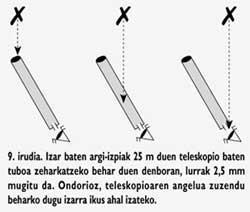
Aberration is the undeniable claim that the Earth is in constant motion. This explains why Bradley's observations and theoretical calculations did not coincide. The concerns raised and exposed so far are the result of an attempt to satisfy the curiosity inherent in the human being. Today we know that all this is so, but we can come to understand phenomena by observing and knowing our environment.





